Home Tags Posts tagged with "royal birth"
royal birth
The King’s Troop Royal Horse Artillery and the Honourable Artillery Company carried out the ceremonial of gun salutes to mark the birth of the royal baby.
Gun salutes are fired for the birth of every prince or princess, no matter where their place is in the line of succession. The last royal salute for a birth was for Princess Eugenie in 1990.
The King’s Troop Royal Horse Artillery, wearing full dress uniform, paraded past Buckingham Palace on the way to Green Park, where they staged a 41-gun royal salute.
They went from their forward mounting base in Wellington Barracks into Green Park, where 71 horses pulled six First World War-era 13-pounder field guns into position for the royal salute at 2 p.m.
Each of the six guns fired blank artillery rounds at 10-second intervals until a total of 41 shots were fired. The horses and riders then collected the guns and escorted them back to Wellington Barracks.
Major Mark Edward, commanding officer of the King’s Troop Royal Horse Artillery, said: “The opportunity to mark the birth of the child of the Duke and Duchess of Cambridge by firing a 41-gun royal salute, comes as a huge honor for the King’s Troop Royal Horse Artillery.”
The Honourable Artillery Company (HAC), the City of London’s Army Reserve Regiment, also fired a 62-gun salute from Gun Wharf at the Tower of London at 2 p.m.
Whilst a royal gun salute normally comprises 21 guns, this is increased to 41 if fired from a royal park or residence.
Uniquely, at the Tower of London, which is a royal residence, 62 rounds are fired as this also includes an additional 21 guns for the citizens of the City of London to show their loyalty to the monarch.
Bells also sounded at Westminster Abbey in celebration of the royal birth, with the three ringers having performed the same task for the new Prince’s father more than 30 years ago.
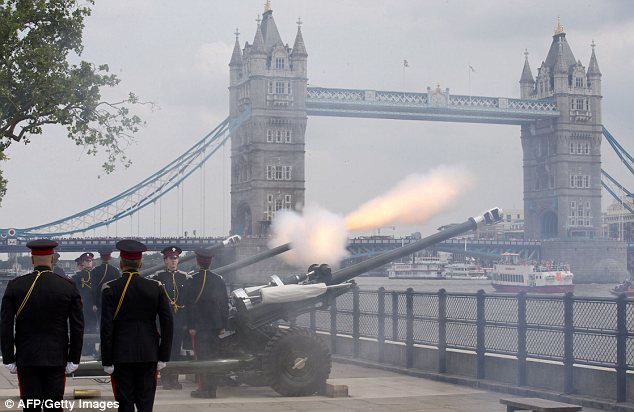
Royal Artillery sound series of gun salutes to mark the birth of the royal baby
When Prince William was born in June 1982, Clarke Walters helped ring a peal at the iconic church in central London in honor of the newest member of the royal family.
Clarke Walters said it was ‘wonderful’ to now be performing the peal for Prince William’s own baby son.
He also rang the celebratory bells for the Duke and Duchess of Cambridge’s wedding at the Abbey two years ago.
A team of 10 from the Westminster Abbey Company of Ringers rang a full peal on the Abbey’s 10 bells from 2pm to coincide with the gun salute in Green Park.
The complex peal is made of 5,000 changes, and known as the Cambridge Surprise Royal and lasts for over three hours.
Clarke Walters said: “It’s always a great honor to ring at the Abbey especially for a big occasion like this one. It’s a bit of a thrill even though I’ve been ringing for more than 30 years.
“I do love the connection that three of us rang the peal for William’s birth, the same three were in the wedding peal and the same three are here today. That’s a nice link back to William.”
Celebrations are not confined to London, as all of Her Majesty’s ships – in home or international waters – are flying the Royal Navy Ensign flag from their mast to mark the birth of the prince.
HMS Lancaster, deployed on a patrol task in the Caribbean, added its own congratulatory message to the Duke and Duchess, spelling out “It’s A Boy!” on the deck of the ship.
Staff from RAF Valley, where Prince William serves as a search and rescue pilot, were among the first to offer their congratulations.
Station commander Group Captain Adrian Hill sent a congratulatory message to the couple on behalf of the RAF Valley.
“We’re all delighted to learn that Flight Lieutenant Wales and the Duchess of Cambridge are now proud parents of a new-born son,” he said.
“We wish them all the very best for the future. From everyone at RAF Valley, congratulations.”
The Ministry of Defence said other units connected to Prince William also marked the birth, including the Army regiment he was commissioned into from Sandhurst, the Household Cavalry, which is partly deployed in Afghanistan.
The Irish Guards, of which Prince William is the colonel, toasted the birth with a traditional glass of Irish stout at their barracks in Aldershot and at bases in London.
Kate Middleton visited the battalion this year and last year to present shamrocks to all ranks on St Patrick’s Day, a role carried out for many years by a female member of the Royal Family.
Trafalgar Square’s famous fountains were lit with blue lights last night and London mayor Boris Johnson said they will be lit for the next six days in celebration of the royal birth.
Westminster City Council celebrated the announcement of the baby boy’s birth with blue lighting in the fountains in Marble Arch and the Golden Jubilee Bridge. They will remain lit up until midnight tonight.
[youtube 3BmZEj49o3U]
It appears James is a clear favorite for the name of the little Prince among the betting public.
At 2/1, James overtook the earlier leader among boys’ names, George, which is now 5/1 as is Henry – Prince Harry’s real name.
Most punters had clearly expected a girl, with Alexandra the favorite at 7/4.
Bookmakers Coral said the royal birth was the biggest non-sporting betting event in the company’s history with cash staked on everything including hair color and weight.
The name Prince William and Kate Middleton choose will set a trend for a generation of babies, with other new parents having a boy anxious to copy them.
James has links to both families, but Prince William already has a cousin called James – the Earl and Countess of Wessex’s son Viscount Severn.
George has been the name of six Kings of England and was the Sovereign name of the Queen’s father, George VI, whose actual first name was Albert.
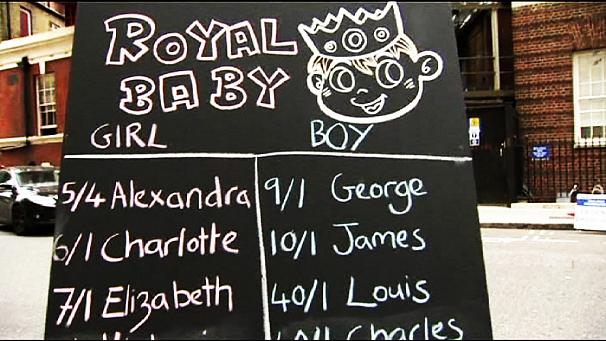
The name Prince William and Kate Middleton choose will set a trend for a generation of babies, with other new parents having a boy anxious to copy them
It is also one of Prince Charles’ middle names.
From Prince William’s side of the family both his father’s name, which the Prince of Wales share with Princess Diana’s brother, Earl Spencer, and his grandfather’s are likely favorites.
At the bookies however, Charles did not even hit top ten with William Hill, and Phillip-betters will take home 40 times the money if they win.
Kate Middleton and Prince William are also likely to take inspiration from Kate’s side of the family, possibly honoring her father Michael, or picking Francis, which is both her father and her grandfather’s middle name.
TOP TEN BETTED BOY NAMES
1) James (2/1)
2) George (5/1)
3) Henry (5/1)
4) Arthur (20/1)
5) Louis (25/1)
6) Albert (40/1)
7) Alexander (40/1)
8) Benjamin (40/1)
9) David (40/1)
10) Philip (40/1)
(source: William Hill and Coral)
[youtube 5BwGWBq0gMk]
[youtube I5TNDGv-iLc]
Kate Middleton, the Duchess of Cambridge, is in the early stages of labor and was admitted to hospital at around 5.30 a.m. today as she prepares to give birth to the future king or queen.
There have been weeks of anticipation over the forthcoming birth of the Duke and Duchess of Cambridge’s child.
Here are ten of the lesser-known facts about royal births:
1. Home secretaries used to attend royal births. The last time was in 1936 for the birth of the Queen’s cousin, Princess Alexandra. The custom was ended in 1948 ahead of the birth of Prince Charles. At the time Home Office researchers could find no evidence for the belief that the home secretary’s presence was anything to do with verification, according to a biography of the Queen written by Ben Pimlott.
Then Home Secretary Sir William Joynson-Hicks was present at the Queen’s birth in 1926, despite the government being embroiled in a row with coal miners. He was reported to have conveyed the news by special messenger to the Lord Mayor of London.
2. The Archbishop of Canterbury won’t attend the birth, as was the custom in the past. One exception was in 1841 for the birth of Queen Victoria’s first son Albert Edward in 1841 when the archbishop and two companions – Lord Wharncliffe, Lord President of the Council, and Lord Stanley, Secretary of the State for the Colonies – turned up late and missed the birth. The Times does not record whether heavy carriage traffic was to blame. The Bishop of London did make it.
3. 42 eminent public figures were called in to verify the birth of King James II’s son James Francis Edward in 1688 at St James’s Palace, in what visiting Cambridge University scholar Prof. Mary Fissell describes as “the first media circus surrounding a royal birth”. People doubted that the King’s wife Mary of Modena was genuinely pregnant and, once she went into labor, Mary Fissell says, there were rumors spread by cheap broadsheets and in coffee houses that the baby who emerged had been smuggled into the bedchamber in a warming pan, or that it had been sneaked into the bed through a secret door in the bedhead.
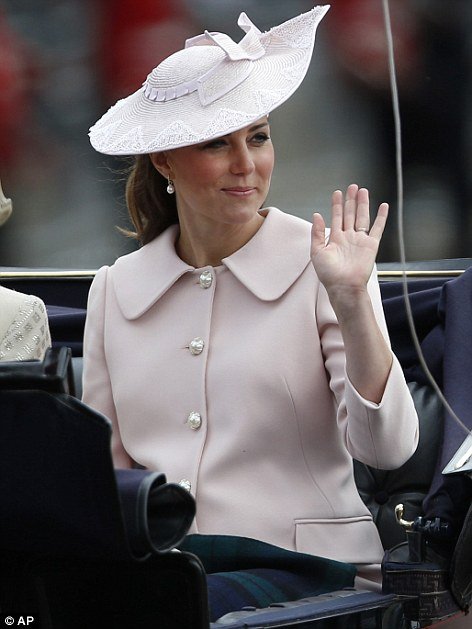
Kate Middleton is in the early stages of labor and was admitted to hospital as she prepares to give birth to the future king or queen
That scandal put a permanent question mark against the baby’s legitimacy, Mary Fissell says, and he never became king. William of Orange and his wife Mary went on to seize the throne in 1688 in what came to be known as the Glorious Revolution.
4. The birth of Princess Margaret in 1930 caused some difficulty for then Home Secretary JR Clynes. He had remained in Scotland while he waited to witness the birth of the princess at Glamis Castle which ended up happening two weeks later than planned, says royal historian Hugo Vickers. When the baby was finally on its way, JR Clynes was already ready for bed, but on the news of the impending arrival had to scramble to the castle for the birth.
5. A surname will not necessarily be required, as the new baby will have the title HRH Prince or Princess and will be referred to in this way. However, if Kate Middleton and Prince William want to include a surname, there are three choices available: Mountbatten-Windsor, Wales or Cambridge. In 1917 George V adopted Windsor – after the castle of the same name – as the “surname” of his family, changing it from Saxe-Coburg and Gotha as a result of anti-German feeling during World War I.
The Queen and Prince Phillip combined their surnames to make Mountbatten-Windsor – their direct descendants can use this name but it isn’t binding.
In his military role, Prince William uses the name of his royal house – Wales – which is taken from his father. Similarly Cambridge, the title given to the couple when they married, could be used.
6. The news will come on an easel. It’s custom for news of royal births and deaths to be attached to the railings of Buckingham Palace. In this case, it will be displayed on an ornate easel in the forecourt of the palace. The Queen, senior members of the royal family, and the Middleton family – if they are not at the hospital – will be told about the birth first. Then a royal aide will hurry from the hospital to the palace under police escort with a bulletin. The foolscap-sized note, bearing the Buckingham Palace letterhead and signed by key medical staff, will be the nation’s first chance to find out if it is a boy or a girl. After the note is displayed, an announcement will be posted on Twitter and Facebook, and the media will be informed.
7. Prince William is following modern convention by taking paternity leave. He is expected to take the two weeks’ paid leave offered by the Ministry of Defence. He will then return to his job as an RAF search and rescue pilot. Of course, statutory paternity leave has only been in force in the UK since 2003. Prince Phillip was playing squash when Charles was born.
8. Royal births are usually celebrated with a 41-gun salute by the King’s Troop Royal Horse Artillery. The basic royal salute is 21 rounds, but because it will be conducted in Green Park, a royal park, an extra 20 rounds are fired. At the Tower of London, 62 rounds will be fired – the basic 21, 20 because the Tower is a Royal Palace and 21 for the “city of London”. Union jacks will also be flown from all Government buildings, Royal Naval ships, and defense establishments.
9. The birth is in a hospital. While it might seem obvious that Prince William and Kate Middleton’s baby would be born in a hospital, Prince William was actually the first would-be king to arrive in such a way. Both he and his brother Prince Harry were born in the private Lindo Wing of St Mary’s Hospital in Paddington, west London, where Kate Middleton is giving birth. The baby will be delivered by the Queen’s former gynaecologist Marcus Setchell. The Queen was born at a home belonging to her mother’s parents at 17 Bruton Street in Mayfair, London. The current heir to the throne, Prince Charles, was born at Buckingham Palace, while his sister Anne was born at Clarence House.
The new parents are likely to present the newborn baby to the world via the press camped outside the hospital. The Queen showed off the royal babies on the balcony at Buckingham Palace in front of huge crowds.
10. The christening robe will be a replica of one that has been used since 1841. It is not yet known where the latest addition to the family will be christened, but Prince William – like his father the Prince of Wales – was christened by the Archbishop of Canterbury in the Music Room at Buckingham Palace. The robe was made for the christening of Queen Victoria’s eldest daughter. Made of fine Honiton lace lined with white satin, it has subsequently been used for generations of Royal christenings. The current Queen wore it, her children all wore it and so have all but one of her grandchildren – including Princes William and Harry. In 2008, the Earl and Countess of Wessex’s son wore a replica robe designed to preserve the original.
The arrival of Kate Middleton and Prince William’s first child is to be marked with a commemorative £5 silver coin.
The coin will feature an image of St. George and the Dragon first seen on a sovereign designed by Italian engraver Benedetto in 1817.
It was used last year on a limited edition coin to mark the Queen’s Diamond Jubilee.
A source told the Daily Telegraph: “The Royal Mint’s plan is to announce it will be bringing out the silver coin when the royal baby is born.”
Kate Middleton and Prince William do not know the sex of their baby, which is expected imminently.
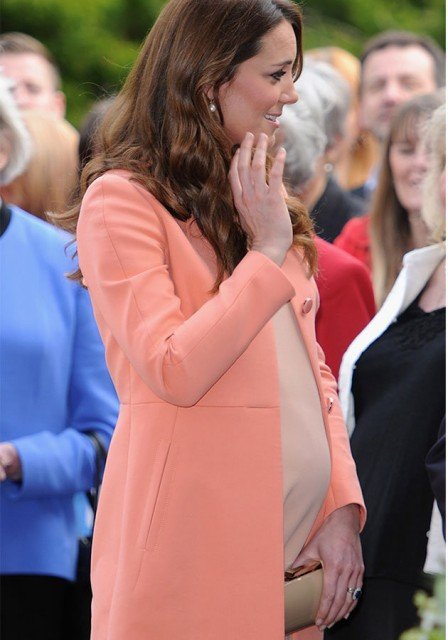
The arrival of Kate Middleton and Prince William’s first child is to be marked with a commemorative £5 silver coin
Photographers and reporters have been camped for days outside St Mary’s hospital in London, where Kate is imminently due to give birth to the future heir.
The Royal Mint has already revealed that babies born on the same day as the new prince or princess will be given a “lucky” silver penny.
Bookmakers have revealed they have taken a large number of bets on the potential name of the Royal couple’s child.
One of the names which many members of the public believe the baby could be called is George.
Bookmakers give the odds of the baby being called George at 10-1.
If Prince William and Kate Middleton named their child George, it would become King George VII.
It is believed the Royal Baby could result in a £250 million ($400 million) boost for Britain’s shops.
Speculation that Kate Middleton was expecting an early birth was quashed earlier this week after it emerged that Prince William plans to play in a charity polo match tomorrow.
Prince William will take part in the game at Cirencester Polo Club in Gloucestershire but he will not be accompanied by his heavily pregnant wife. She will not want to leave her London “safety zone” so close to her due date.
Kate Middleton herself let slip earlier this year that their baby was due in mid-July, a fact which has since been confirmed by palace officials.
[youtube eWKKTMI0q04]
Princess Caroline of Monaco has become a grandmother after Andrea Casiraghi’s fiancée, Colombian heiress Tatiana Santo Domingo gave birth to a baby boy on Thursday.
The family are yet to announce the newborn’s name.
Andrea Casiraghi, 28, is the oldest son of Princess Caroline and the nephew of Monaco’s ruling sovereign, Prince Albert II.
Prince Albert II is the son of late actress Grace Kelly and Prince Rainier III of Monaco.
The Monaco palace said Princess Caroline is overjoyed by the newest addition to the jet set royal family.
According to Hello magazine, the new baby will be third in line to the Monaco throne, behind Andrea Casiraghi (who currently has no title) and Princess Caroline, who is first.
This line of succession would change if reigning monarch Prince Albert and his wife Charlene were to welcome a child before Andrea Casiraghi and Tatiana Santo Domingo marry.
A royal birth is usually greeted with fanfare in Monaco, and will certainly be baptized.
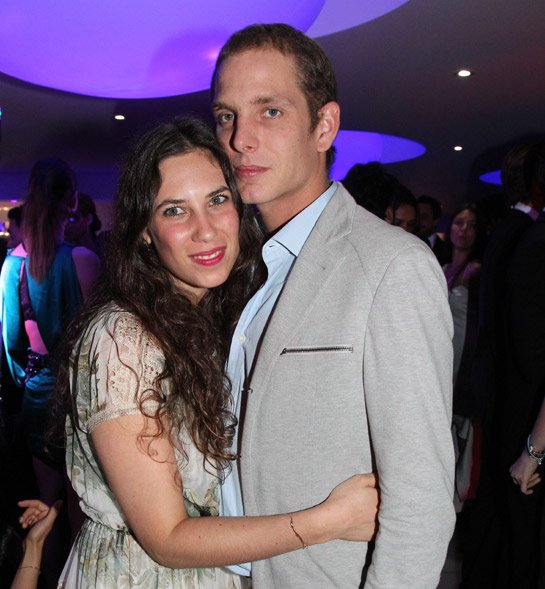
Andrea Casiraghi has become a father after Tatiana Santo Domingo gave birth to a baby boy
Andrea Casiraghi’s sister, Charlotte has been tipped to be godmother.
The fact that Andrea Casiraghi and Tatiana Santo Domingo, 29, were expecting was never officially announced, though rumors were confirmed in November when Tatiana was spotted with a sizeable bump.
Tatiana Santo Domingo and Andrea Casiraghi, who announced their engagement in July last year, are relatively publicity-shy.
Andrea Casiraghi’s fiancée is the daughter of the late Julio Santo Domingo, named by Forbes in 2011 as the second richest man in Colombia, and Vera Rechulski, a former Brazilian socialite from Sao Paolo currently living in Paris.
They have known each other for eight years and met while studying at the same school in Paris.
No date has been fixed for the royal wedding but it is understood it will take place this year.
Andrea Casiraghi is the son of the late Stefano Casiraghi, the second husband of Princess Caroline, who died in a boating accident off Monte Carlo in 1990.





